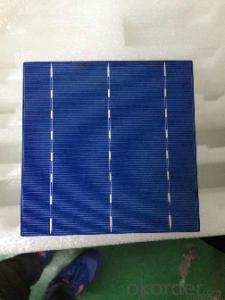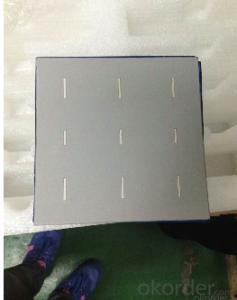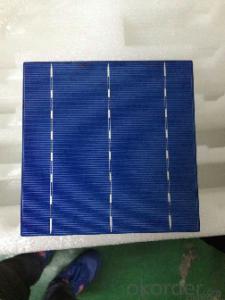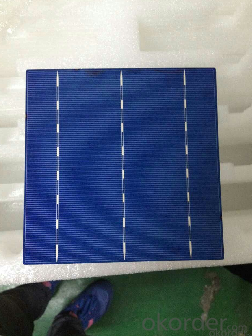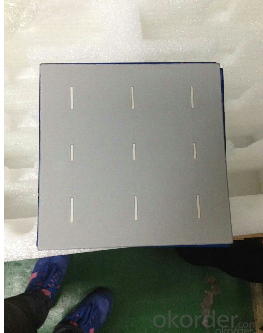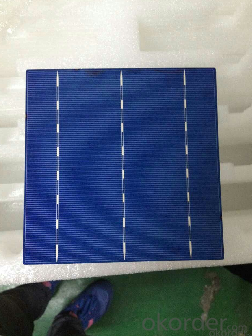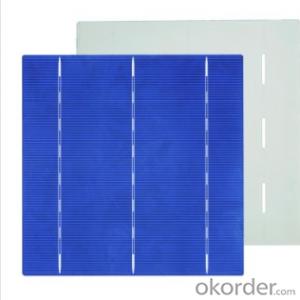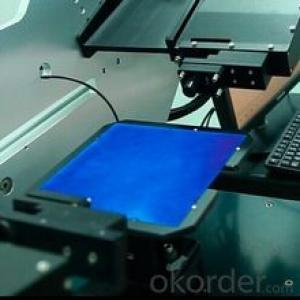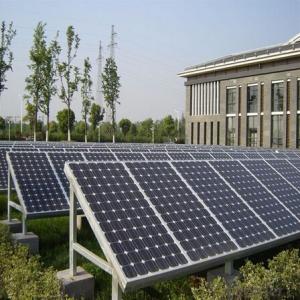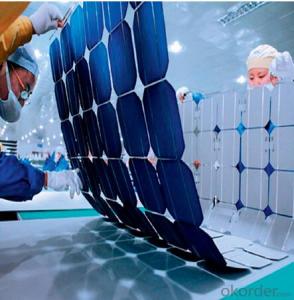Ternary Organic Solar Cells Poly Solar 156mmx156mm Cells from CNBM Solar
- Loading Port:
- China main port
- Payment Terms:
- TT OR LC
- Min Order Qty:
- 500 pc
- Supply Capability:
- 10000000 pc/month
OKorder Service Pledge
OKorder Financial Service
You Might Also Like
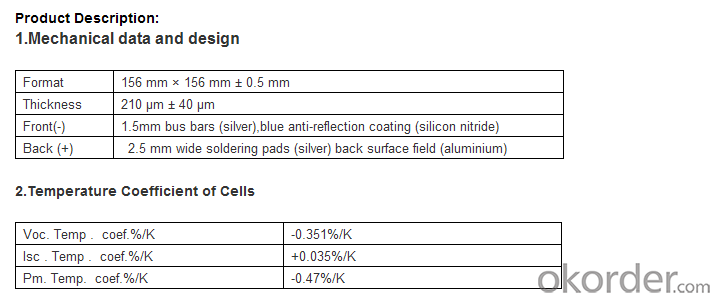
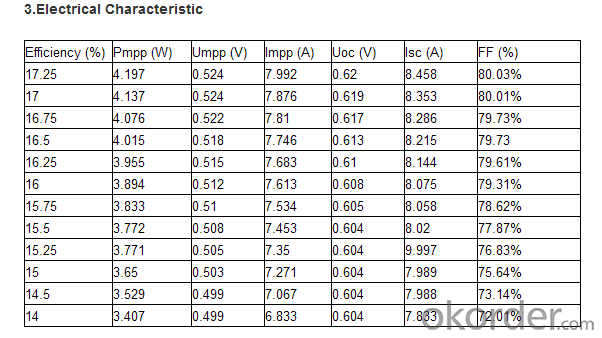
4.Specifications
1. High conversionefficiency
2.Superior quality
3.Lowest price
4.Certificate:CE,ROHS,IEC,TUV,UL.
5. Prompt delivery
5.Feature:
High conversion efficiencies resulting in superior power outputperformance
Outstanding power ourput even in low light or high temperatureconditions
Optimized design for ease of soldering and lamination
Long-term stability,reliability and performance
Low breakage rate
Color uniformity
6.Quality Assurance & Control
ISO9001 quality management system and ISO14001 environmentalmanagement system standard are completely implemented in our company's solarcell manufacture process.
1, classified efficiency grades by both minimum power and powercurrent
2, Screened for reverse current and shunt resistance
3, Constant reliability monitoring
4, Sorted into four defined color classes
5, Minimal button marks
6, No beading
7,Low warpage and bowing
8, REACH-SVHC and RoHS compliant
7.Images
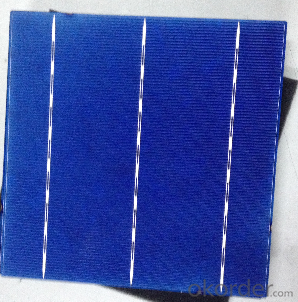
8.FAQ
What's your advantages?
1. High efficiency and High power.
2. Long-term electrical stability.
3. Lowest price and Fastest delivery.
4. Good quality and good service.
5. Bulk supply
6. Good Warranty
7. Big Sale
8. More than 25 years on the lifetime.
- Q: Can solar cells be damaged by hail or other weather events?
- Yes, solar cells can be damaged by hail or other severe weather events. Hailstones, strong winds, and heavy debris can crack or break the delicate glass surface of solar panels, reducing their efficiency or rendering them completely non-functional. Therefore, it is important to consider the durability and quality of solar panels when installing them in areas prone to such weather conditions.
- Q: Can solar cells be used in agriculture for irrigation?
- Yes, solar cells can be used in agriculture for irrigation. Solar-powered irrigation systems can efficiently harness solar energy to power water pumps, ensuring a sustainable and cost-effective solution for farmers. This reduces reliance on fossil fuels and electricity grids, enabling remote and off-grid farming locations to have access to water for irrigation.
- Q: Can solar cells be used for water desalination?
- Yes, solar cells can be used for water desalination. Solar energy can be harnessed to power the desalination process, where the energy from the sun is converted into electricity by solar cells and used to separate the salt and impurities from seawater, making it suitable for drinking or agricultural purposes. This method, known as solar desalination, is an environmentally friendly and sustainable solution for addressing water scarcity in coastal areas.
- Q: Can solar cells be used for powering telecommunications towers?
- Yes, solar cells can be used to power telecommunications towers. In fact, solar power is increasingly being used as a reliable and sustainable source of energy for powering remote or off-grid telecommunication infrastructure. Solar panels can be installed on the rooftops or adjacent to the towers to generate electricity from sunlight, providing an eco-friendly and cost-effective solution for powering these towers.
- Q: How much does a solar cell weigh?
- The weight of a solar cell typically varies depending on its size and type, but on average, a standard solar cell weighs around 3 to 4 pounds (1.4 to 1.8 kilograms).
- Q: Can solar cells be used in data centers or server farms?
- Yes, solar cells can be used in data centers or server farms. By installing solar panels, these facilities can generate renewable energy to power their operations. However, the feasibility and effectiveness of using solar cells in data centers may depend on factors such as the location, available space, energy demands, and storage capacity. Additionally, combining solar power with other energy sources and implementing energy-efficient practices can further optimize the sustainability of data centers and server farms.
- Q: Can solar cells be used for off-grid applications?
- Yes, solar cells can be used for off-grid applications as they convert sunlight into electricity and can be utilized in remote areas or places lacking access to the traditional power grid. They provide a sustainable and reliable source of energy for powering various off-grid applications such as cabins, RVs, boats, and remote communication systems.
- Q: What is the impact of dust and dirt on solar cell efficiency?
- Dust and dirt can significantly reduce the efficiency of solar cells. When dust and dirt particles accumulate on the surface of solar panels, they block sunlight from reaching the photovoltaic cells, thereby reducing the amount of electricity generated. This buildup can cause a decrease in energy production by up to 20%. Regular cleaning and maintenance of solar panels are crucial to ensure optimal efficiency and maximize the electricity output of the system.
- Q: Can solar cells be used in telecommunications infrastructure?
- Yes, solar cells can be used in telecommunications infrastructure. They can power various components of the infrastructure such as cell towers, base stations, and remote equipment. Solar cells provide a reliable source of renewable energy that can be harnessed to meet the power requirements of telecommunications systems, particularly in remote and off-grid locations. This helps reduce dependence on traditional grid electricity and lowers the carbon footprint of the infrastructure.
- Q: Can solar cells be used for powering offshore oil rigs?
- Yes, solar cells can be used for powering offshore oil rigs. They can be installed on the rig's surface or nearby platforms to capture sunlight and convert it into electricity. This renewable energy source can help reduce the reliance on traditional fossil fuels and lower the carbon footprint of offshore operations. However, the feasibility and efficiency of using solar cells for offshore oil rigs would depend on factors such as location, weather conditions, and energy demand of the rig.
Send your message to us
Ternary Organic Solar Cells Poly Solar 156mmx156mm Cells from CNBM Solar
- Loading Port:
- China main port
- Payment Terms:
- TT OR LC
- Min Order Qty:
- 500 pc
- Supply Capability:
- 10000000 pc/month
OKorder Service Pledge
OKorder Financial Service
Similar products
Hot products
Hot Searches
Related keywords
